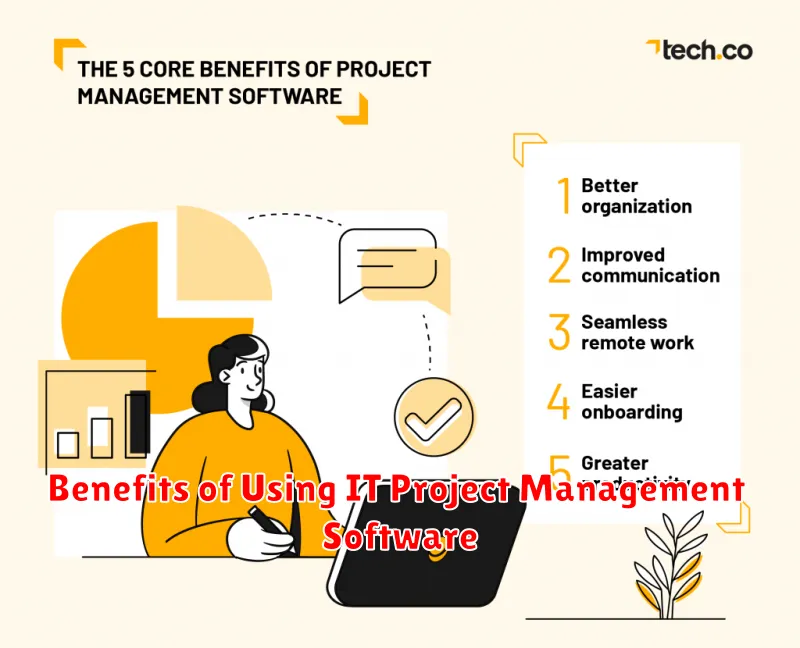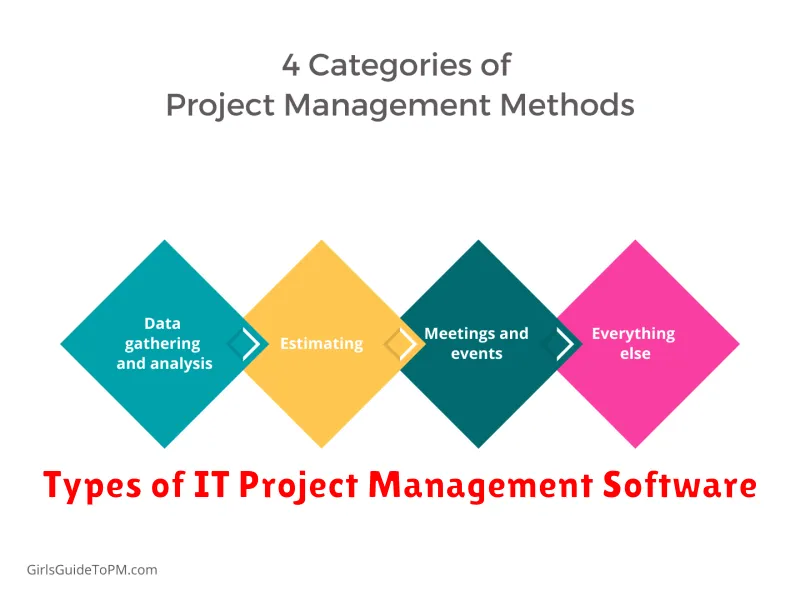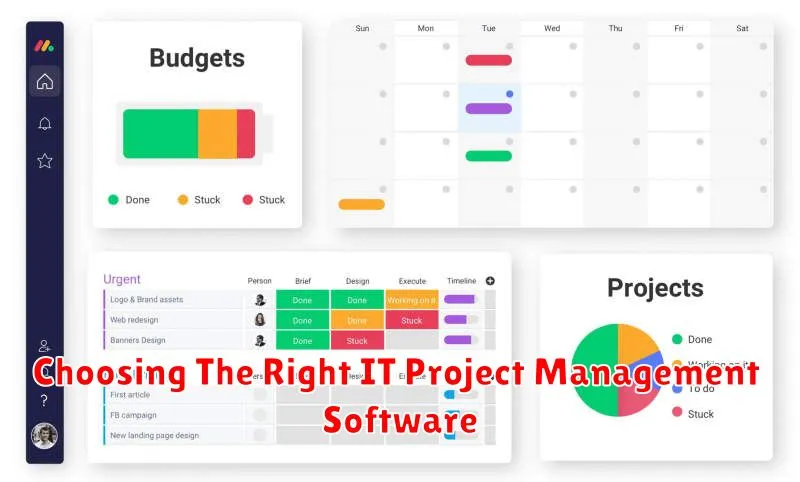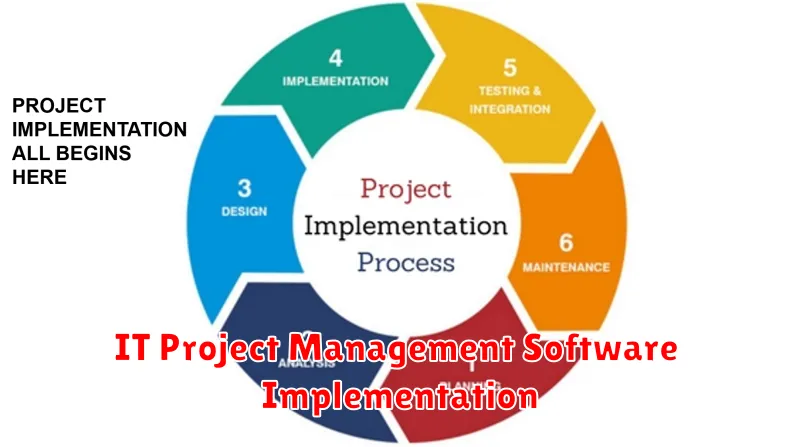Are you tired of struggling to keep your projects on track? Feeling overwhelmed by deadlines, scattered data, and a lack of clear communication? You’re not alone. Many businesses find themselves battling these challenges, leading to missed milestones, budget overruns, and frustrated teams. But there’s a solution: IT project management software.
This powerful tool can revolutionize the way you manage your projects, offering a centralized hub for planning, collaboration, and tracking progress. From creating detailed project plans to assigning tasks, monitoring budgets, and communicating effectively with stakeholders, IT project management software provides the structure and support you need to achieve project success.
Introduction: The Importance of Effective IT Project Management
In today’s fast-paced digital landscape, businesses are heavily reliant on IT to stay competitive and achieve their goals. However, implementing new IT systems or projects can be complex and challenging, requiring careful planning, execution, and monitoring. This is where effective IT project management comes into play.
Effective IT project management is crucial for ensuring that projects are delivered on time, within budget, and meet the desired business outcomes. It involves a structured approach to define project scope, establish clear timelines, allocate resources efficiently, and manage risks proactively. By implementing robust project management practices, organizations can streamline their IT initiatives, minimize disruptions, and maximize return on investment.
Key Features of Top-Tier IT Project Management Software
IT project management software is a powerful tool that can help you streamline your projects, improve collaboration, and deliver results on time and within budget. But with so many options available, how do you choose the right software for your needs? Here are some key features to look for in top-tier IT project management software:
Task Management: This feature allows you to create, assign, and track tasks throughout the project lifecycle. Look for software that offers flexibility in task organization, including the ability to create subtasks, dependencies, and deadlines.
Collaboration Tools: Effective collaboration is essential for successful IT projects. The best software will provide features like shared workspaces, real-time communication tools, and file sharing capabilities. This allows team members to work together seamlessly, regardless of their location.
Project Planning and Scheduling: Top-tier software should make it easy to create detailed project plans and schedules. This includes features like Gantt charts, resource allocation tools, and progress tracking.
Risk Management: Identifying and mitigating potential risks is crucial for any IT project. Look for software that includes risk assessment tools, risk tracking, and mitigation plans.
Reporting and Analytics: Robust reporting and analytics capabilities are essential for gaining insights into project performance. Look for software that can generate comprehensive reports on key metrics like budget, timeline, and resource utilization.
Integration: IT projects often involve working with multiple systems. The best software will integrate with other tools you use, such as CRM, ERP, and accounting software.
By choosing software that includes these key features, you can gain a significant advantage in managing your IT projects effectively and achieving your business goals.
Benefits of Implementing IT Project Management Software
In today’s fast-paced digital landscape, successful IT project management is paramount. To streamline operations, enhance efficiency, and achieve desired outcomes, implementing robust IT project management software is essential. This powerful tool offers a myriad of benefits, empowering organizations to navigate complexities and achieve their project goals.
Improved Collaboration and Communication
IT project management software fosters seamless collaboration and communication among team members, stakeholders, and vendors. Centralized platforms provide a single source of truth for project information, documents, and updates. This eliminates confusion and ensures everyone is on the same page, leading to better decision-making and increased productivity.
Enhanced Task Management and Organization
With its advanced task management capabilities, IT project management software allows for effective task assignment, prioritization, and tracking. Teams can easily create and manage tasks, set deadlines, and monitor progress. This organized approach ensures that no task slips through the cracks, leading to a smoother workflow and improved project delivery.
Increased Visibility and Reporting
IT project management software provides real-time visibility into project status, progress, and key performance indicators (KPIs). Comprehensive reporting features allow managers to track project metrics, identify potential risks, and make informed decisions. This transparency enhances accountability and empowers teams to stay on track.
Improved Risk Management
Identifying and mitigating risks is crucial for project success. IT project management software incorporates robust risk management capabilities, enabling teams to proactively assess potential threats, develop mitigation strategies, and track their effectiveness. This proactive approach minimizes surprises and helps teams stay ahead of potential issues.
Streamlined Budget Management
Managing project budgets effectively is essential for financial success. IT project management software provides tools for budgeting, tracking expenses, and monitoring resource allocation. This centralized approach ensures that projects remain within budget constraints, avoiding costly overruns and maximizing ROI.
Conclusion
Implementing IT project management software offers numerous benefits, empowering organizations to streamline their projects, enhance collaboration, improve efficiency, and achieve their goals. By leveraging the power of this technology, businesses can unlock their potential and thrive in the competitive digital landscape.
Choosing the Right IT Project Management Software for Your Needs
In today’s fast-paced digital world, effective project management is crucial for success. IT project management software plays a vital role in streamlining workflows, enhancing collaboration, and ensuring projects are delivered on time and within budget. With numerous options available, selecting the right software can be overwhelming. This article will guide you through the key factors to consider when choosing the best IT project management software for your needs.
1. Project Complexity and Size: The first step is to assess the complexity and size of your IT projects. Do you manage small, short-term projects or large, complex initiatives spanning months? Software designed for agile development might be ideal for smaller, iterative projects, while solutions with robust resource management and budgeting features are better suited for large-scale projects.
2. Team Size and Collaboration Needs: Consider the size of your IT team and their collaboration requirements. Software with strong communication and collaboration features is essential for teams spread across multiple locations. Look for tools that enable real-time updates, document sharing, and effective task assignment.
3. Integration Capabilities: Seamless integration with your existing tools is crucial. Ensure the software integrates with your CRM, ERP, or other essential applications to avoid data silos and streamline processes.
4. Budget and Pricing Model: Determine your budget and explore different pricing models. Some software offers fixed monthly fees, while others charge per user or project. Evaluate the value proposition of each option and choose a model that aligns with your financial constraints.
5. User Interface and Ease of Use: The software should be user-friendly and intuitive for your team. A clean and visually appealing interface will make it easier for users to navigate and adopt the tool. Consider trying out free trials or demos to experience the software firsthand.
6. Customization and Flexibility: Flexibility is key. Look for software that can be tailored to your specific workflows and project management methodology. Consider features like custom dashboards, reporting options, and the ability to create workflows that suit your needs.
7. Security and Compliance: Data security is paramount, especially when dealing with sensitive IT project information. Choose software with robust security measures and compliance certifications to protect your data and ensure compliance with relevant regulations.
8. Support and Documentation: Reliable customer support is essential. Look for software providers that offer comprehensive documentation, tutorials, and responsive support to address any technical issues or questions you may encounter.
By considering these factors, you can narrow down your options and choose the best IT project management software to enhance your team’s productivity and efficiency. Investing in the right software can transform your IT project management process and drive better outcomes.
Best Practices for Successful IT Project Management
IT project management is crucial for successful technology initiatives. With the right tools and practices, you can ensure your projects stay on track, meet deadlines, and deliver the desired outcomes. Here are some key best practices for successful IT project management:
1. Define Clear Project Scope and Objectives: Before embarking on any project, it’s vital to have a well-defined scope and clear objectives. This ensures everyone understands the project’s goals, deliverables, and boundaries.
2. Establish a Detailed Project Plan: A comprehensive project plan is essential for organizing tasks, timelines, and resources. This plan should include milestones, dependencies, and risk assessments, providing a roadmap for the project’s execution.
3. Use Effective Communication Tools: Open and transparent communication is vital for successful project management. Utilize communication tools such as project management software, email, and regular meetings to keep stakeholders informed and engaged.
4. Implement Agile Methodologies: Agile methodologies, like Scrum and Kanban, promote iterative development and flexibility. This allows for adjustments and improvements based on feedback and changing requirements.
5. Embrace Collaboration Tools: Leverage collaboration tools to facilitate teamwork, knowledge sharing, and document management. These tools can streamline communication and enhance project efficiency.
6. Conduct Regular Project Monitoring and Reporting: Monitor project progress closely using dashboards and reports to identify potential roadblocks or deviations from the plan. This allows for timely adjustments and course correction.
7. Prioritize Risk Management: Identify potential risks throughout the project lifecycle and implement mitigation strategies. This proactive approach helps to minimize disruptions and ensure project success.
8. Conduct Post-Project Reviews: After project completion, review the project’s successes and failures to learn from the experience and improve future projects. This continuous improvement process is essential for ongoing project management success.
By implementing these best practices, you can streamline your IT projects, enhance collaboration, and ultimately achieve successful outcomes. Remember, effective IT project management is a journey of continuous learning and adaptation.
Integrating IT Project Management Software with Existing Systems
Integrating your new IT project management software with your existing systems is crucial for maximizing its benefits. It eliminates data silos, streamlines workflows, and provides a holistic view of your projects. By connecting your software with systems like CRM, ERP, and accounting platforms, you can automate processes, reduce manual data entry, and gain valuable insights into project performance.
Consider these key integration aspects:
- Data synchronization: Ensure seamless data flow between your project management software and other systems. This allows for real-time updates and eliminates inconsistencies.
- Workflow automation: Automate tasks like creating project tickets, assigning resources, and generating reports. This saves time and reduces errors.
- Centralized reporting: Access comprehensive project data from various sources in one central location. This enables informed decision-making and provides a clear picture of project progress.
When integrating, consider factors like:
- Your existing systems: Determine compatibility and potential challenges.
- Project management software features: Choose software with robust integration capabilities.
- Integration methods: Explore options like API integrations, data connectors, or middleware solutions.
By carefully planning and implementing integrations, you can leverage the power of your IT project management software to streamline operations, improve collaboration, and ultimately, achieve project success.
Measuring the Success of Your IT Projects
In the realm of IT project management, success is not merely a matter of completing a project on time and within budget. It’s about delivering a solution that truly meets the needs of your business and drives tangible value. To effectively measure the success of your IT projects, you need a comprehensive framework that goes beyond the traditional metrics. This article will explore key aspects of measuring project success, focusing on the critical elements that contribute to a truly impactful outcome.
1. Business Alignment: The core principle of success lies in ensuring your IT project aligns with your business goals. Ask yourself: Does the project directly address a key business challenge? Does it contribute to revenue growth, cost reduction, or improved efficiency? A clear connection between your project and business objectives is crucial.
2. User Adoption: A successful IT project isn’t just about delivering a functional solution. It’s about users embracing and utilizing it. Measure user adoption rates, track feedback, and assess the impact on user productivity and satisfaction.
3. ROI and Value Realization: Quantify the return on investment (ROI) and measure the tangible value generated by the project. This might involve calculating cost savings, increased revenue streams, or improvements in operational efficiency. Track key performance indicators (KPIs) related to the project’s intended outcomes.
4. Stakeholder Satisfaction: Success encompasses satisfying all stakeholders involved, including management, end-users, and IT teams. Conduct surveys and collect feedback to gauge overall satisfaction levels.
5. Process Improvement: Evaluate the impact of the project on your organization’s processes and workflows. Did it streamline operations, improve communication, or reduce bottlenecks? Assess the efficiency gains and identify areas for further optimization.
By diligently measuring these key success factors, you can gain a comprehensive understanding of your IT project’s impact. This data-driven approach allows you to refine your project management processes, ensure alignment with business goals, and drive continuous improvement.
Case Studies: Real-World Examples of IT Project Management Success
IT project management software has become indispensable for organizations of all sizes. It provides a structured framework for planning, executing, and monitoring projects, ensuring they stay on track and deliver the desired outcomes. To truly understand the transformative power of these tools, let’s delve into some compelling real-world case studies.
Case Study 1: Streamlining Software Development at Acme Corporation
Acme Corporation, a leading software development company, faced challenges with managing their numerous projects. Deadlines were missed, communication breakdowns were frequent, and resources were often overstretched. They implemented an IT project management software solution that enabled them to:
- Centralize project information: All project documentation, communication, and progress updates were consolidated in one platform, improving visibility and collaboration.
- Automate task management: The software automated task assignment, tracking, and reminders, freeing up valuable time for team members to focus on high-impact activities.
- Enhance communication: Real-time messaging and notifications facilitated seamless communication between team members, stakeholders, and clients.
The results were remarkable. Acme Corporation experienced a 20% reduction in project delays, a 15% improvement in project efficiency, and a significant increase in customer satisfaction.
Case Study 2: Implementing a New CRM System at XYZ Company
XYZ Company, a retail organization, wanted to implement a new CRM system to improve customer relationship management and drive sales. However, the project was complex and involved multiple teams and stakeholders. By leveraging IT project management software, they were able to:
- Define clear project scope and objectives: The software provided a framework for outlining project goals, deliverables, and timelines.
- Manage risks effectively: Risk assessment and mitigation tools helped identify potential roadblocks and develop contingency plans.
- Track project budget and resources: The software allowed for real-time monitoring of project expenses, resource allocation, and potential cost overruns.
The implementation was completed on time and within budget. XYZ Company saw a 10% increase in sales leads, a 5% improvement in customer retention rates, and a significant boost in employee productivity.
These case studies demonstrate the tangible benefits of IT project management software. From streamlining workflows and improving communication to enhancing collaboration and achieving project goals, these tools empower organizations to achieve success in today’s dynamic business environment.
Future Trends in IT Project Management Software
IT project management software is a vital tool for any organization looking to streamline processes, enhance collaboration, and achieve successful project outcomes. As technology continues to evolve at a rapid pace, so too does the landscape of project management software. This article will explore some of the key trends shaping the future of IT project management software.
Artificial Intelligence (AI) and Machine Learning (ML) will play an increasingly significant role in optimizing project management processes. AI-powered tools can analyze data, predict potential roadblocks, and recommend solutions, enabling project managers to make more informed decisions. ML algorithms can automate repetitive tasks, freeing up time for more strategic initiatives.
Agile methodologies have already gained significant traction in the IT sector, and this trend is only expected to intensify. Agile project management software will continue to evolve, providing more robust support for iterative development cycles, sprint planning, and real-time collaboration.
Integration with other tools is becoming increasingly crucial as organizations leverage a variety of software applications. The future of IT project management software will see seamless integration with communication platforms, CRM systems, and other relevant tools, creating a unified and efficient workflow.
Cloud-based solutions are becoming the dominant model for IT project management software. Cloud platforms offer scalability, flexibility, and affordability, making them an attractive option for organizations of all sizes. The adoption of cloud-based solutions will continue to rise, enabling organizations to access project management tools from anywhere, anytime.
Focus on user experience is paramount. As competition in the project management software market intensifies, vendors are striving to provide intuitive and user-friendly interfaces. Intuitive designs, personalized dashboards, and mobile optimization will be key to attracting and retaining users.
By embracing these trends, IT project management software will become even more powerful and transformative, enabling organizations to achieve their project goals efficiently and effectively.
Conclusion: Empowering Your Teams with the Right Tools
In conclusion, embracing the power of IT project management software is not just about streamlining your projects; it’s about empowering your teams to work smarter and achieve greater success. By providing them with the right tools, you equip them with the ability to:
- Collaborate effectively across geographical boundaries and time zones.
- Gain real-time visibility into project progress and identify potential roadblocks early on.
- Manage resources efficiently, optimizing time and budget allocation.
- Automate repetitive tasks, freeing up valuable time for strategic initiatives.
- Track and analyze project performance, enabling data-driven decision-making.
Investing in the right IT project management software is an investment in the future of your organization. It empowers your teams to work smarter, fosters a culture of collaboration and accountability, and ultimately drives better business outcomes. So, take the leap and equip your team with the tools they need to succeed.
Key Features of IT Project Management Software

IT project management software is an essential tool for any organization that wants to streamline its projects and deliver high-quality results. These software solutions offer a wide range of features designed to simplify project planning, execution, and monitoring. Let’s explore some of the key features that make IT project management software so powerful.
Task Management: At the heart of any project lies the ability to manage tasks efficiently. IT project management software provides tools for creating, assigning, prioritizing, and tracking tasks. This functionality ensures that every team member is aware of their responsibilities and progress can be monitored closely.
Collaboration and Communication: Successful projects hinge on effective collaboration and communication. IT project management software fosters a collaborative environment by offering features like shared workspaces, instant messaging, file sharing, and real-time updates. This ensures everyone is on the same page, minimizing misunderstandings and delays.
Resource Management: Managing resources effectively is crucial for project success. IT project management software allows you to allocate resources (both human and material) efficiently. It enables you to track resource availability, utilization, and costs, helping you optimize resource allocation and avoid overspending.
Time Tracking and Reporting: Time is a precious commodity in project management. IT project management software provides tools for tracking time spent on tasks and generating comprehensive reports. These reports offer valuable insights into project progress, resource allocation, and overall efficiency.
Risk Management: Every project carries inherent risks. IT project management software helps you identify, assess, and mitigate potential risks. It enables you to create risk registers, track risk mitigation plans, and monitor the impact of risks on project progress.
Budgeting and Cost Control: Staying within budget is critical for any project. IT project management software facilitates budget planning, tracking, and control. It allows you to set budget constraints, monitor project expenditures, and generate financial reports, ensuring you stay within financial limits.
Integration and Customization: Modern IT project management software seamlessly integrates with other business applications, such as CRM systems, email platforms, and accounting software. This ensures data consistency and streamlines workflow. Furthermore, many solutions offer customization options to tailor the software to your organization’s specific needs.
Benefits of Using IT Project Management Software

IT project management software has become an indispensable tool for businesses of all sizes. Its ability to streamline workflows, enhance communication, and optimize resources has revolutionized the way projects are executed. By leveraging these powerful platforms, organizations can reap significant benefits, ultimately driving success and achieving their goals.
Improved Collaboration and Communication: One of the primary advantages of IT project management software is its ability to facilitate seamless collaboration among team members. With centralized platforms, everyone can access project plans, tasks, and updates in real-time. This eliminates information silos and ensures that everyone is on the same page, fostering effective communication and minimizing misunderstandings.
Enhanced Task Management and Organization: Effective task management is crucial for project success. IT project management software provides a structured framework for assigning, tracking, and managing tasks. Features like task lists, timelines, and progress tracking tools help teams stay organized, prioritize tasks, and ensure that deadlines are met.
Increased Efficiency and Productivity: By automating repetitive tasks and streamlining workflows, IT project management software significantly increases efficiency and productivity. Team members can focus on higher-value activities, reducing wasted time and effort. Automation also minimizes errors and ensures that tasks are completed accurately and consistently.
Improved Resource Allocation and Management: Managing resources effectively is essential for successful project execution. IT project management software provides tools for resource allocation, tracking, and management. This allows project managers to optimize resource utilization, prevent overallocation, and ensure that the right people are working on the right tasks.
Enhanced Risk Management and Mitigation: Every project faces risks, and identifying and mitigating these risks is crucial for project success. IT project management software offers features for risk identification, assessment, and tracking. This helps teams proactively manage potential issues, develop contingency plans, and minimize the impact of unforeseen circumstances.
Better Project Visibility and Reporting: IT project management software provides real-time insights into project progress and performance. Dashboards and reports offer comprehensive overviews of key metrics, allowing stakeholders to track progress, identify bottlenecks, and make informed decisions. This improved visibility enables better communication and transparency, fostering accountability and driving results.
Streamlined Budgeting and Cost Management: Effective cost management is essential for maintaining profitability and staying within budget. IT project management software offers tools for budgeting, expense tracking, and financial reporting. This helps teams monitor spending, identify areas for cost optimization, and ensure that projects are completed within budget constraints.
In conclusion, IT project management software offers a multitude of benefits that can significantly enhance project execution, improve team collaboration, and drive business success. From improved communication and task management to enhanced risk mitigation and resource allocation, these powerful platforms provide the tools and capabilities needed to streamline projects, increase efficiency, and achieve optimal outcomes.
Types of IT Project Management Software

Navigating the vast sea of IT project management software can feel overwhelming. But don’t worry, there’s a perfect solution for every team and project! We’ll break down the key types to help you find the right fit.
1. Cloud-Based Project Management Software
Cloud-based software is the most popular choice for its accessibility and flexibility. It allows teams to work from anywhere, collaborate seamlessly, and access real-time updates. Popular cloud-based options include Asana, Trello, Monday.com, and Wrike.
2. On-Premise Project Management Software
On-premise solutions are installed directly on your company’s servers. This offers more control over data security and customization but requires more IT resources for setup and maintenance. Examples include Microsoft Project, Atlassian Jira, and Oracle Primavera P6.
3. Agile Project Management Software
Designed for iterative and collaborative development, agile software focuses on flexibility and rapid iteration. It’s ideal for projects with changing requirements. Popular agile solutions include Scrum, Kanban, and Lean. You can find software that supports these methodologies.
4. Gantt Chart Software
Gantt chart software visually represents project timelines, tasks, and dependencies. This offers a clear overview of the project roadmap and helps identify potential delays. Popular options include Microsoft Project, Smartsheet, and GanttPRO.
5. Resource Management Software
Focusing on workforce optimization, resource management software helps allocate team members effectively to projects. It tracks availability, skills, and workload, preventing overallocation and ensuring project success. Examples include Mavenlink, LiquidPlanner, and Workfront.
With diverse options available, it’s crucial to understand your project’s needs, team size, and budget. Consider factors like collaboration features, reporting capabilities, integrations, and pricing. The right software can streamline your workflow, improve communication, and ultimately, lead to successful IT projects.
Choosing The Right IT Project Management Software

In the ever-evolving landscape of technology, IT project management software has become an indispensable tool for organizations seeking to streamline their operations, enhance collaboration, and ensure successful project delivery. With a myriad of options available, choosing the right software can be a daunting task. This article will guide you through the essential factors to consider when selecting the most suitable IT project management software for your needs.
1. Project Requirements and Scalability: Begin by defining your specific project requirements, such as the complexity of projects, team size, and desired functionalities. Consider the software’s scalability to accommodate future growth and expansion of your project portfolio.
2. Features and Functionality: Evaluate the software’s features, such as task management, collaboration tools, risk management, reporting, and integrations with other tools. Choose a solution that offers a comprehensive set of functionalities to meet your specific project needs.
3. User Interface and Ease of Use: The software’s user interface should be intuitive and user-friendly, allowing all team members to easily navigate and utilize its features. Consider the learning curve and provide training to ensure seamless adoption.
4. Security and Data Protection: Data security is paramount in IT project management. Ensure that the software provider implements robust security measures, such as data encryption, access controls, and regular security audits.
5. Budget and Pricing: Determine your budget and evaluate the software’s pricing models, including subscription fees, per-user costs, and any additional features or integrations. Consider the value proposition and long-term cost-effectiveness.
6. Vendor Support and Training: Assess the vendor’s customer support options, including documentation, online resources, and dedicated support teams. Training resources should be available to facilitate user adoption and ongoing support.
7. Integrations and Compatibility: Check for integrations with other essential tools that your organization uses, such as communication platforms, CRM systems, and cloud storage services. Ensure seamless data flow and operational efficiency.
By carefully considering these factors, you can make an informed decision and choose the IT project management software that best aligns with your specific requirements, fostering project success and driving organizational growth.
IT Project Management Software Implementation

In today’s fast-paced digital world, efficient project management is crucial for success. IT project management software provides a comprehensive solution to streamline your projects, improve collaboration, and enhance productivity. Implementing the right software can be transformative for your organization, but it requires careful planning and execution.
Here’s a step-by-step guide to ensure a smooth implementation process:
1. Define Your Needs
Start by clearly defining your project management requirements. Identify the specific functionalities you need, such as task management, resource allocation, communication tools, reporting capabilities, and integrations with existing systems. Consider your team size, project complexity, and budget constraints.
2. Research and Select Software
Research different IT project management software options available in the market. Explore their features, pricing models, user reviews, and industry reputation. Consider factors like ease of use, customization options, and mobile compatibility.
3. Pilot Project
Before implementing the software across your entire organization, consider running a pilot project with a small team. This allows you to test the software’s functionality, identify potential challenges, and gather feedback from early adopters.
4. Training and Onboarding
Provide comprehensive training to your team on how to use the software effectively. This includes hands-on sessions, documentation, and ongoing support. Ensure everyone is comfortable with the platform before full implementation.
5. Integration and Customization
Integrate the software with your existing systems, such as email, calendar, and CRM. Consider customizing the software to fit your specific workflow and processes.
6. Ongoing Monitoring and Optimization
Regularly monitor the software’s performance and gather feedback from your team. Identify areas for improvement and make necessary adjustments to optimize the software’s use.
By following these steps, you can ensure a successful implementation of IT project management software that empowers your organization to deliver projects on time and within budget.

